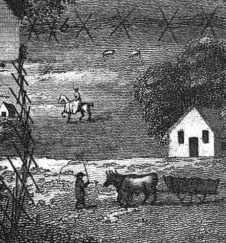Robert Sutcliff's Travels in Some Parts of North America
J.T. lodging place was a "few miles up the river Potapsco" after leaving Baltimore. After visiting Ellicott's Mills, he traveled with T.M. (Thomas Moore) of Sandy Spring to George-town. More on Moore's 1802 refrigerator HERE
"8th Month, 6th. I left Baltimore, in company with T. M. of Sandy Springs. In the evening we reached George-Town, where he is employed, by the corporation, to fill up the deep channel of the Patowmack, on the south side of Mason's Island, in order to turn the stream of that river to the side next to George-Town, that the harbour may be deepened. This night I lodged at Wm. Morgan's, in George-Town, at whose house T. Moor also lodged.
8th Month, 7th. I went to Washington city. The next day I visited
Doctor Thornton, of the Patent Office, and was shown a variety of curious
models. … In the afternoon I visited General Mason's residence on Mason's
Island, which is a very beautiful spot. In this excursion I had the company of
T. Moor, Samuel Brooks, and the Mayor of the city, who assisted in rowing the boat.
The great officers of these cities are not above occasional offices of this
kind. In the evening, I came to Wm. Morgan's, and lodged there.
8th Month, 9th. I sailed down the Patowmack to Alexandria…"
The Frontispiece of Sutcliff's book - A Farm-House in the Back Settlements. (not EC)
a. The stumps that remain of trees which have been girdled. This operation consists in taking off 2 or 3 inches of the bark all round the trees; in consequence of which, they die and are blown down by the wind, leaving stumps remaining below the girdled part of the tree.
b. A Worm Fence. This construction, like the operation just described, is a proof of the little value ef timber in the parts where these fences are commonly found. It consists of piles of rough rails, the ends of which cross each other at irregular angles, as obtuse as the requisite stability of the fence will allow, forming a zigzag line of division- The fence is supported at the angles by stakes driven into the ground, and fastened to the upper timbers or rails.
American Friends going to Meeting in Summer - on waggons
The open carriages described in this plate, are called waggons, and the best of them Jersey waggons- They are made very light, hung on springs with leather braces, and travel very pleasantly. They are covered at the top with canvas painted- On the sides, there are three rows of curtains, and those in the outer row
American Friends going to Meeting in a settled Frost
With their carriages placed on sledges, as described. This practice obtains not only in the beaten roads round the cities; but in country places also, as the plate exhibits.
The frost still continuing very intense, the use of wheel
carriages was in a great measure discontinued: even the stage coaches being
placed on sliders. Carriages fitted up in this way, glide along with such
silent celerity, that the laws require the horses should have small bells fixed
to their harness, that passengers in the streets may have notice of their
approach; otherwise they would be liable to many accidents. 'On level ground,
or in the most trifling descents, there is so little friction upon the sliders,
that I have often noticed the traces to be quite slack for a considerable time,
when they have been driving along with great swiftness; the pressure on the
reins being sufficient to keep the carriage in motion. The noise of carriage
wheels, which is, in general, very considerable, especially in the principal
streets; is now supplanted by the tinkling of bells on every hand.
Sutcliff, Robert. Travels
in Some Parts of North America: In the Years 1804, 1805 & 1806. Phila: 1812
©2017 Patricia Bixler Reber
Forgotten history of Ellicott City & Howard County MD





No comments:
Post a Comment